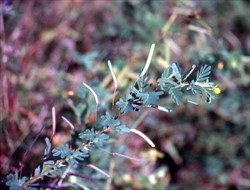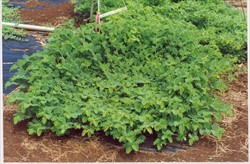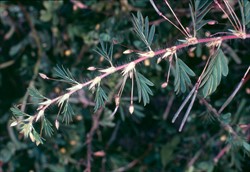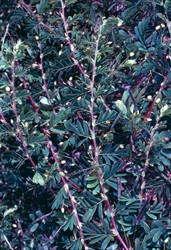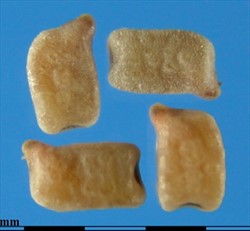Chamaecrista pilosa
Tropical Forages
Chamaecrista pilosa (L.) Greene
Subordinate taxa:
Chamaecrista pilosa (L.) Greene var. luxurians (Benth.) H.S. Irwin & Barneby
Chamaecrista pilosa (L.) Greene var. pilosa
var. pilosa: Basionym: Cassia pilosa L.
var. luxurians: Basionym: Cassia trichopoda var. luxurians Benth.
Family: Fabaceae (alt. Leguminosae) subfamily: Caesalpinioideae tribe: Cassieae subtribe: Cassiinae.
Short-lived perennial or self-regenerating annual herb, with somewhat lignified mature stems; sparsely branched, erect to 65 cm, or procumbent. Heavily grazed plants adopt a low rosette growth habit. Stems densely pilose with spreading and appressed short white hairs. Leaves pinnate, with (3‒) 4‒5 (‒6) leaflet pairs, petioles short (2‒6 mm), rachises 2‒3 cm long; leaflets oblong or oblong-obovate, 5‒25 mm long, 3‒7 mm wide, rounded at the apex and mucronate, ciliate, glabrous or sparsely pilose, with conspicuous elevated nerves, asymmetric (midrib closer to the abaxial margin); stipules ovate-lanceolate, 6‒13 mm long, long-acuminate, striate-nerved, ciliate, subcordate; petiole short (2‒3 mm) with petiolar gland small, sometimes none. Flowers axillary, mostly borne singly on filiform pedicels, mostly longer than leaf rachises; sepals lanceolate, 4‒5 mm long, sparsely pilose or glabrous; petals yellow, 5‒7 mm long. Pods linear oblong, 2‒4 cm long, 3‒4 mm wide, rounded and apiculate at the apex, sparsely appressed-pubescent or glabrate, with numerous obliquely transverse seeds, elastically dehiscent; seeds rectangular, flattened, ±2 mm long, c. 400,000‒450,000 seeds/kg.
English: hairy sensitive pea
Latin America: palma-do-campo (general term for Chamaecrista spp. in the Caatinga, Brazil)
var. luxurians
Native:
South America: Brazil (Bahia, Ceará, Goiás, Maranhão)
var. pilosa
Native:
Northern America: Mexico (Chiapas); U.S.A. (Florida)
Caribbean: Cuba; Dominican Republic; Jamaica; Trinidad and Tobago (Trinidad)
Central America: El Salvador; Guatemala
South America: Colombia; Venezuela
Forage
Could be sown into native pastures to augment feed quality, or into pastures of improved grasses. Limited value for conservation or standing hay because of substantial leaf drop under dry conditions, leaving woody indigestible stem.
Environment
Cultivated in Venezuela to stabilise sand dunes. Could be used as a ley or phase legume in crop-livestock systems to improve cereal production.
Soil requirements
Best adapted to friable, well-drained light soils of low to moderate fertility, but will grow on moderately heavy clay soils. However, it does not regenerate effectively on hard-setting or surface-sealing soils. Has been grown successfully on soils with pH ranging from about 5 to 7, and may be calciphobic.
Moisture
Found in dry or moist open places, sometimes on sandbars along streams. While average annual rainfall (AAR) at collection sites in the tropics have been as low as 500 mm, C. pilosa generally requires better moisture conditions than does C. rotundifolia. Other collection sites have AAR above 1,000 mm, and the species has been grown successfully in the subtropics in areas with up to 1,625 mm AAR. In cultivation, it is probably best sown in areas with AAR from 900 to 1,600 mm. As with C. rotundifolia, heavily-grazed, low stands are more drought tolerant than large plants.
Temperature
This is a warm-season species, with a wide spectrum of temperature adaptation, having been collected from areas in the tropics with 24-hour average annual temperature (AAT24) of 27.4 °C (SD 0.7), and grown successfully in the subtropics with AAT24of 19.4 °C (SD 4.2). It is native to, became naturalized in, or has been grown successfully from about 28° N to 29° S, and to about 850 m asl (16° N, Mexico). Well-developed C. pilosa plants can survive light frost, but there tends to be significant leaf-shed after frost. Some smaller plants are killed by frost, but there is usually sufficient soil seed to ensure re-establishment.
Light
Grows best in full light. CPI 57503 yields declined in trials in Bali and North Sulawesi, Indonesia, when grown under coconuts (light transmission 58% and 73%).
Reproductive development
Flowering indeterminate. In S hemisphere subtropics, perennating plants commence flowering in early summer. However, if sown mid-January, the first flower may not appear until late February or early March.
Defoliation
If cut or grazed early, plants adopt a decumbent growth or even prostrate habit. Low cutting of mature plants can result in plant death.
Fire
Fire in associated mature grass can kill plants of C. pilosa, but stands recover from plentiful soil seed.
Guidelines for establishment and management of sown forages.
Establishment
Seed must not be hot water treated to break dormancy as it aggregates due to the mucilaginous layer on the seed surface. Seed germinates quickly after rainfall; seedlings grow rapidly and early-flowering types can flower within 6 weeks. It nodulates satisfactorily with native rhizobia or with broad spectrum strains such as CB 756 in Australia, which is also suited to species such as Macroptilium atropurpureum. Seed is best broadcast on the surface of a well-prepared seedbed, lightly covered and rolled.
Fertilizer
Not demanding in terms of soil fertility, but may respond to additions of fertilizer, particular phosphorus, on low fertility soils.
Compatibility with other species
As with most short-lived perennials, C. pilosa requires bare soil for recruitment of new plants as old plants die out. Thus it is not compatible with denser, sward-forming species such as Cynodon dactylon.
Companion species
Grasses: Bothriochloa bladhii, B. pertusa, Chloris gayana, Digitaria eriantha, Heteropogon contortus, Urochloa mosambicensis and a range of other grasses.
Legumes: Aeschynomene falcata, Listia bainesii, Stylosanthes guianensis var. intermedia.
Pests and diseases
No pests or diseases of any consequence have been recorded to date. However, laboratory tests have demonstrated susceptibility to Alternaria cassiae and Sclerotium rolfsii, but resistance to Phomopsis, Colletotrichum dematium f sp. crotalariae, Macrophomina phaseolina and Pseudocercospora nigricans.
Seed set can be markedly reduced through attack by pod-sucking species such as Nezara viridula and Riptortus serripes.
Ability to spread
C. pilosa sets profuse quantities of seed, and has the potential to spread beyond the sown area. However, it appears to display less tendency to spread than many of the provenances of C. rotundifolia sown at the same sites. It spreads more readily on soils with a friable surface than on those with a hard-setting surface.
Weed potential
It has certain weedy characteristics like prolific seeding, hard seed, relative ease of establishment, and adaptation to low fertility soil, but does not appear to have been declared a significant weed in any country, other than “In Jamaica, occasional as a weed of waste places on alluvial soils”.
Nutritive value
In one experiment, nitrogen and neutral detergent fibre levels measured in the tops range from 1.07 - 2.54% and 70.1 – 43.5% respectively. In another measuring seasonal variation in nutrient levels in the tops, N levels varied from 1.4 – 3.4%, P from 0.04 – 0.26%, Ca from 0.4 – 0.9%, Mg from 0.23 – 0.43%, while Na was mostly about 0.01%.
Palatability/acceptability
CPI 57503 is usually well-eaten by cattle, and may be somewhat more palatable than C. rotundifolia. It was also well eaten in feeding experiments with rats, suggesting it may have application in rabbit production.
Toxicity
Feeding experiments with rats show CPI 57503 to be non-toxic. However, in view of the within-species variation in liveweight gain in other legume species tested, this assessment must be treated as unique to that accession.
Note: The agronomic and nutritional information above relates to experience with a single accession, CPI 57503 (see below).
Dry matter
DM yields of up to 3.4 t/ha have been achieved in the subtropics in Australia.
Animal production
No information.
No information
As with many tropical legumes, harvesting seed from ripe pods can be difficult, particularly in the heat of the day, when the slightest touch can trigger explosive dehiscence of pods. It is therefore usually best to harvest early in the morning, collecting yellowing pods that are already ripe as well as mature pods. Dry in the sun under fine mesh or in paper bags. With sequential, non-destructive harvesting, most seed can be collected, but with a single destructive harvest, losses may exceed 50% of the possible crop. Total seed production has been measured up to over 1 tonne/ha.
Tolerant of pre-planting trifluralin. No further information, but may be similar to C. rotundifolia: “Susceptible to 2,4 -D and to acifluorfen, moderately tolerant of fluazifop-butyl and sethoxydim.” Effective control once established is difficult due to high levels of seedling recruitment from soil seed.
- Adapted to low-fertility soil.
- Prolific seed production.
- Persistent under grazing.
- Needs well-drained soil.
- Not very drought-hardy.
Chakraborty, S., Charudattan, R. and de Valerio, J.T. (1994) Reaction of selected accessions of forage Cassia spp. to some fungal pathogens. Tropical Grasslands 28:32–37. bit.ly/2WLjNs7
Izaguirre-Mayoral, M.L., Vivas, A.I. and Oropeza, T. (1995) New insights into the symbiotic performance of native tropical legumes: I. Analysis of the response of thirty-seven native legume species to artificial shade in a neotropical savanna. Symbiosis 19:111–129. hdl.handle.net/10222/77446
Jones, R.M. (2001) Evaluation of legumes and grasses in coastal south-east Queensland. Tropical Grasslands 35:85–95. bit.ly/2UDlllf
Kaligis, D.A. and Sumolang, C. (1991) Forages species for coconut plantations in North Sulawesi. In: Shelton, H.M. and Stür, W.W. (eds) Forages for Plantation Crops. Proceedings of a workshop, Sanur Beach, Bali, Indonesia. 27–29 June 1990. ACIAR Proceedings No. 32. Australian Centre for International Agricultural Research (ACIAR), Canberra, Australia. p. 45–48. aciar.gov.au/node/8081
Minggang, X. McDonald, C.K., Liu, C.J. and Hacker, J.B. (2000) Variation in temperature requirements for germination and early seedling root development in Chamaecrista rotundifolia and three allied species. Genetic Resources and Crop Evolution 47:25–34. doi.org/10.1023/A:1008775221573
Njarui, D.M.G., Beattie, W.M., Jones, R.K. and Keating, B.A. (2004) Evaluation of forage legumes in the semi-arid region of Eastern Kenya. I. Establishment, visual bulk rating, insect pests and disease incidences of a range of forage legumes. Tropical and Subtropical Agroecosystems 4:33–55. redalyc.org/articulo.oa?id=93940105
Rika, I.K., Mendra, I.K., Gusti Oka, M. and Oka Nurjaya, M.G. (1991) New forage species for coconut plantations in Bali. In: Shelton, H.M. and Stür, W.W. (eds) Forages for Plantation Crops. Proceedings of a workshop, Sanur Beach, Bali, Indonesia. 27–29 June 1990. ACIAR Proceedings No. 32. Australian Centre for International Agricultural Research (ACIAR), Canberra, Australia. p. 41–44 aciar.gov.au/node/8081
Standley, P.C. and Steyermark, J.A. (1946) Flora of Guatemala. Fieldiana: Botany 24. p. 123–124. doi.org/10.5962/bhl.title.2233
Strickland, R.W., Greenfield, R.G., Wilson G.P.M. and Harvey, G.L. (1985) Morphological and agronomic attributes of Cassia rotundifolia Pers., C. pilosa L., and C. trichopoda Benth., potential forage legumes for northern Australia. Australian Journal of Experimental Agriculture 25:100–108. doi.org/10.1071/EA9850100
Strickland, R.W., Lambourne, L.J. and Ratcliff, D. (1987) A rat bioassay for screening tropical legume forages and seeds for palatability and toxicity. Australian Journal of Experimental Agriculture 27:45–53. doi.org/10.1071/EA9870045
None released.
